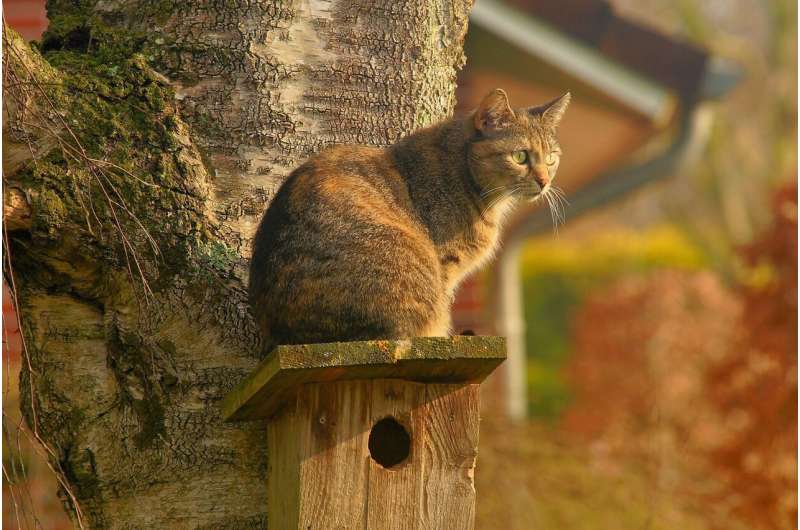This article has been reviewed according to Science X's editorial process and policies. Editors have highlighted the following attributes while ensuring the content's credibility:
fact-checked
preprint
trusted source
proofread
20-year review of avian flu in cats reveals rising danger from latest strain

A University of Maryland review of scientific literature suggests domestic cats can contract the rapidly evolving bird flu H5N1, potentially putting owners, veterinarians and others at risk if the virus continues to circulate unabated.
The study, available in preliminary form on MedRxiv while awaiting peer review, examined the global distribution and spread of bird flu infections in feline species between 2004 and 2024, finding a drastic rise in reports starting in 2023, with a spike in infections reported among domestic cats, as opposed to wild or zoo-kept animals.
This increase coincides with the rapid spread of the current strain of H5N1 among mammals, says the study's first author, Assistant Professor Kristen Coleman, an airborne infectious disease researcher in the School of Public Health and an affiliate professor in the Department of Veterinary Medicine.
Bird flu hasn't been reported to be contagious between humans, and it is not certain to evolve in that direction, but the disease is clearly changing. The current strain of H5N1 has been spreading to animals that have never been affected before, and pets that can pass it to people could play a role in how it evolves.
Beginning in Texas this April, dairy cattle in 12 states have contracted bird flu, as have three people who worked with infected cows in Texas and Michigan. Along with the infected workers in Texas, two farm cats fed unpasteurized milk also caught the illness.
The U.S. Centers for Disease Control and Prevention, which provides guidance for veterinarians working with potentially infected animals, said the risk of contracting the disease from pets is low, but Coleman suggested pet owners should take precautions to protect their cats and themselves.
"Don't feed your cat raw meat or raw dairy milk, and limit their unsupervised time outdoors," she said. "Cats prey on wild birds that could be infected, and they could get into raw dairy milk on a farm if it is not securely stored."
In addition, the virus has been reported in house mice, which cats also prey on, so it appears the opportunities for cross-species transmission are increasing, and pet cats may be at increased risk.
Cat owners should also be watching for respiratory and neurological symptoms, and consider taking them to the vet if they seem to have trouble breathing or are acting unusually. The current H5N1 strain has also reportedly caused blindness in cats.
Since the emergence of H5N1 in U.S. dairy cattle, 21 domestic cats have been reported to be infected. Full genetic sequences of the viral strains infecting two of these cats have been reported in the scientific literature. Coleman said sequencing and demographic data for the other cat cases are urgently needed.
Avian influenza, or bird flu, was once a finicky disease, infecting mostly migratory waterfowl and farmed poultry. But since 2020, the highly infectious strain known as H5N1 began spreading among a wider variety of birds. It has recently been appearing in a growing number of mammals, even decimating whole colonies of sea lions throughout South America.
Although the disease is new among many animals, cats have been occasional victims of avian influenza for decades, most likely because they eat birds and are exposed through sick or dead prey carrying the virus.
Coleman reported that the fatality rate for the current strain of H5N1 in cats has been around 67%—in itself a good reason reason for pet owners to keep their cats inside and away from wild birds. She also found other worrying indicators, including multiple reports of cats contracting bird flu from other cats.
In addition, both zookeepers and animal shelter workers have contracted bird flu from cats in their care. Although not the current H5N1 strain, these cases reveal cats as potential vectors for the disease in humans.
Coleman suggested that cats and other animals should be monitored for the disease not only for their sake, but for the protection of human health as well.
"The virus is going to sneak up in more places, just like it did in dairy farms," she said. "We know cats are being infected, so let's get ahead of it."
More information: Kristen K. Coleman et al, Avian Influenza Virus Infections in Felines: A Systematic Review of Two Decades of Literature, MedRxiv (2024). DOI: 10.1101/2024.04.30.24306585




















